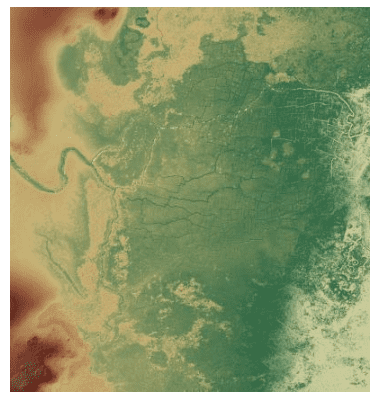The Mayans‘ advanced urban and rural infrastructure altered ecosystems within globally important tropical forests, increasing atmospheric carbon dioxide and methane through burn events and farming, according to a new study.

Understanding agricultural subsistence is vital for understanding past complex societies. Wetland agriculture was often crucial to ancient cultures, and this is particularly what researchers looked at here. While not the first study to look at the environmental footprint of the ancient Maya, this one combined airborne lidar (light detection and ranging) imagery with excavation and dating evidence in wetlands. This allowed researchers to get a birds-eye view of the anthropogenic impact of the Mayans, which they were then able to confirm using data taken from the field.
Researchers concluded the Maya had earlier, more intensive and more wide-ranging anthropogenic impacts on globally important tropical forests than previously known, adding to the evidence for an early and more extensive Anthropocene — the period when human activity began to greatly affect Earth’s environment.
“We now are beginning to understand the full human imprint of the Anthropocene in tropical forests,” said Tim Beach, the study’s lead author. “These large and complex wetland networks may have changed climate long before industrialization, and these may be the answer to the long-standing question of how a great rainforest civilization fed itself.”
The team acquired 250 square kilometers of high precision laser imagery to map the ground beneath a swamp-forest canopy, unveiling the expansive ancient wetland field and canal systems in Belize that the Maya depended on for farming and trade through periods of population shifts, rising sea levels, and drought.

The Maya faced a set of environmental pressures, including rising sea levels in the Preclassic and Classic periods — 3,000 to 1,000 years ago — and droughts during the Late/Terminal Classic and Early Postclassic periods — 1,200 to 900 years ago. The Maya responded to such pressures by converting forests to wetland field complexes and digging canals to manage water quality and quantity.
“These perennial wetlands were very attractive during the severe Maya droughts, but the Maya also had to be careful with water quality to maintain productivity and human health,” said Sheryl Luzzadder-Beach, the study’s co-author.
The researchers believed that the Maya responded to large population shifts and changing demands for food production by expanding their network of fields and canals in areas accessible by canoe to the broader Maya world. Within the fields, the researchers uncovered evidence of multiple ancient food species, such as maize, as well as animal shells and bones, indicating widespread protein harvesting.
Expanding the wetland complexes added atmospheric CO2, through burning events; and methane, through the creation of wetland farming, the study showed. Indeed, the largest premodern increase of methane, from 2,000 to 1,000 years ago, coincides with the rise of Maya wetland networks, as well as those in South America and China.
“Even these small changes may have warmed the planet, which provides a sobering perspective for the order of magnitude greater changes over the last century that are accelerating into the future,” Beach said.
The researchers believe the Maya wetland footprint could be even larger and undiscernible due to modern plowing, aggradation, and draining. Additional research on the region and its surrounding areas is already revealing the extent of wetland networks and how the Maya used them, painting a bigger picture of the Maya’s possible global role in the Early Anthropocene.
“Our findings add to the evidence for early and extensive human impacts on the global tropics, and we hypothesize the increase of atmospheric carbon dioxide and methane from burning, preparing and maintaining these field systems contributed to the Early Anthropocene,” Beach said.
Journal Reference: “Ancient Maya wetland fields revealed under tropical forest canopy from laser scanning and multiproxy evidence,” by Timothy Beach et al.


